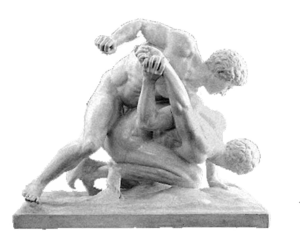Pankration facts for kids

Pankration was an exciting sport in Ancient Greece. It was a bit like wrestling, but with more action! Athletes could use their fists, kick, and hit. The Greeks loved this sport, thinking it showed the best of an athlete's skill and strength.
What Was Pankration?
Pankration was a unique fighting sport. It combined parts of wrestling and boxing. However, athletes did not wear gloves or thongs on their hands. They fought with bare fists. Kicking and hitting were allowed during the match.
Rules of the Game
Even though it was a tough sport, some rules existed. Biting was not allowed. Also, athletes could not poke an eye or a soft spot with a thumb or finger. Umpires watched the matches closely. If an athlete broke a rule, the umpire would whip them. Even with this punishment, rules were often broken.
In regular Greek wrestling, the goal was to throw your opponent. But in pankration, the aim was to make your opponent give up. An athlete might get their opponent in a hold. If the opponent did not surrender, a bone could be broken or a joint dislocated. Size and weight were not as important in pankration. This was because athletes spent much of their time rolling on the ground.
Famous Pankratiasts
The Greeks truly loved pankration. They believed it was the ultimate test of an athlete's skill and power. Pankration was also very popular during the Roman Empire.
The most famous ancient pankratiast was Arrichon of Philageia. He lived in the 6th century BC. Arrichon won the pankration in two different Olympics. Sadly, he died from a stranglehold during the Olympics of 564 BC. Even though he died, he was still given the victor's wreath. Stories about his last fight were told by writers like Philostratus and Pausanias. A statue in the Olympia Museum might be of him.
Images for kids
-
The Pancrastinae. A Roman statue showing the pancratium, which was an event showcased at the Colosseum. Even as late as the Early Middle Ages, statues were put up in Rome and other cities to honour remarkable pankratiasts. This statue is a Roman copy of a lost Greek original, circa 3rd Century B.C.
See also
 In Spanish: Pancracio para niños
In Spanish: Pancracio para niños





